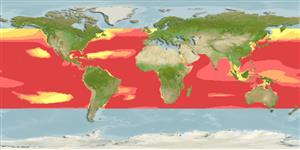Common names from other countries
>
Myctophiformes (Lanternfishes) >
Myctophidae (Lanternfishes) > Notolychninae
Etymology: Notolychnus: Greek, noton = back + Greek, lychnos, -ou = torch (Ref. 45335).
Environment: milieu / climate zone / depth range / distribution range
Ecologia
marinhas batipelágico; oceanódromo (Ref. 51243); intervalo de profundidade 25 - 700 m (Ref. 4066). Deep-water; 56°N - 40°S, 180°W - 180°E
Worldwide distribution in tropical, subtropical and temperate waters. Eastern Atlantic: west of British Isles and Bay of Biscay to South Africa. Western Atlantic: Canada to Argentina. Western Pacific: between 0° and 32°S. Eastern Pacific: between 32°N and 30°S, but with 20°S southern limit in Peruvian Transitional Zone. Eastern Indian Ocean: between 9°-32°S.
Length at first maturity / Tamanho / Peso / Idade
Maturity: Lm 1.7 range ? - ? cm
Max length : 6.3 cm TL macho/indeterminado; (Ref. 26340)
Espinhos dorsais (total) : 0; Raios dorsais moles (total) : 10 - 12; Espinhos anais: 0; Raios anais moles: 12 - 15; Vértebras: 27 - 31. Branchiostegal rays: 9 (Ref. 31422). Anal organs 8; a single deeply set translucent supracaudal gland present in both sexes, but no infracaudal gland; males have much larger eyes and a longer supracaudal gland than those of females (Ref. 39633).
High-oceanic, epipelagic and mesopelagic (Ref. 4479). Found between 375-700 m during the day and between 25-350 m at night (Ref. 4066). Size stratification with depth during the day only (Ref. 4775). Juveniles migratory; adults migratory, partially migratory or non-migratory (Ref. 4775). Feed on copepods, conchoecid ostracods and euphausiids (Ref. 4775). Oviparous, with planktonic eggs and larvae (Ref. 31442). Also Ref. 58302.
Hulley, P.A., 1990. Myctophidae. p. 398-467. In J.C. Quero, J.C. Hureau, C. Karrer, A. Post and L. Saldanha (eds.) Check-list of the fishes of the eastern tropical Atlantic (CLOFETA). JNICT, Lisbon; SEI; Paris; and UNESCO, Paris. Vol. 1. (Ref. 4479)
Categoria na Lista Vermelha da IUCN (Ref. 130435)
CITES (Ref. 128078)
Not Evaluated
Ameaça para o homem
Harmless
Utilização humana
Ferramentas
Relatórios especiais
Descarregue XML
Fontes da internet
Estimates based on models
Preferred temperature (Ref.
115969): 10 - 22.8, mean 15.2 (based on 1055 cells).
Phylogenetic diversity index (Ref.
82804): PD
50 = 1.0000 [Uniqueness, from 0.5 = low to 2.0 = high].
Bayesian length-weight: a=0.00389 (0.00180 - 0.00842), b=3.12 (2.94 - 3.30), in cm Total Length, based on all LWR estimates for this body shape (Ref.
93245).
Nível Trófico (Ref.
69278): 3.1 ±0.20 se; based on food items.
Resiliência (Ref.
120179): Médio, tempo mínimo de duplicação da população 1,4 - 4,4 anos (tmax=1; k >0.30).
Fishing Vulnerability (Ref.
59153): Low vulnerability (10 of 100).
